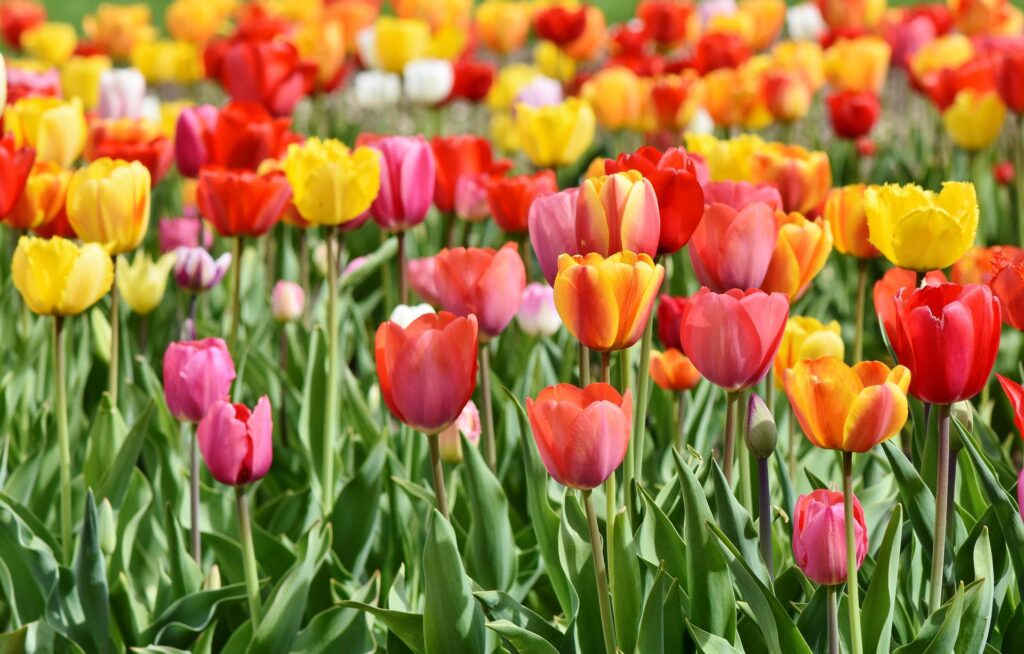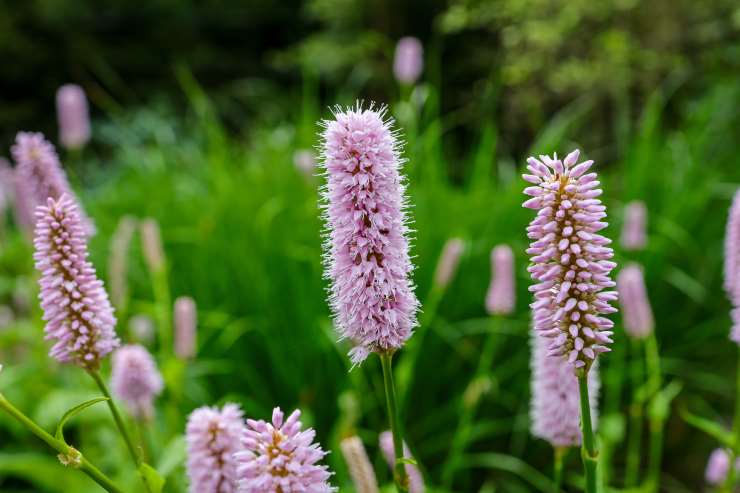Tulip Farming: How to Plant and Harvest Tulips
Tulip farming is quite successful as tulips are quite expensive flowers. Tulips are one of the most beautiful flowers to exist in the world. Tulips are known for their striking beauty and their bulbous flowers which are a feast to the eye. These wonderous flowers belong to the family of Liliaceae. Tulips belong to the genus Tulipa L. Tulips, because of their beauty are excellent ornamental flowers.
These tulips can be grown on the farm or the greenhouse or the poly house or even in the same net. The tulips can also be grown in pots, containers, basins, and so on. Thus, tulips when grown for commercial benefits are grown on farmlands. Tulips, however, are not grown very much in India, because India is quite a hoe. Tulips require a cold and chill climate to thrive. Thus, in India, they are mainly grown in hilly areas such as Himachal Pradesh, Jammu, and Kashmir.

Description of tulips
Tulips are very pretty flowers and thus are one of the most used decorative flowers. Tulips are spring-blooming perennials. These tulips grow from bulbs. Tulips are also of several varieties. Depending on their variety their appearance changes. Thus, the smallest tulip is around 10 cm tall, while the tallest tulip could be around 70 cm.
The appearance of the tulips is the most striking feature. Tulip flowers are shaped like an egg. They have 6 petals, which are arranged in such a way that they resemble the appearance of an egg. The shade of the tulips may be single-color or multi-colored, depending on their variety. These tulips also have different patterns on them which are based on their species.
These attractive flowers come in a huge range of colors. The colors of the tulip flowers are immense and may range from red, orange, pink, cherry, apricot, mauve, brown, scarlet, terracotta, lilac, yellow, salmon, etc. This immense availability of colors makes tulips as one of the most preferred decorative plants.
Varieties of tulips
Tulips are of many varieties. There are many different kinds of tulips that may slightly differ from one another. These different types of tulips are all grown over the globe. However, there are three main categories of tulips. These are the early-flowering tulips, mid-flowering, and late-flowering tulips. A few of early flowering tulips are the single early tulips and the double early tulips.
A few of the mid-flowering tulips are Triumph and mendel. The late flowering tulips are parrot, Darwin, Double Late, and so on. These are the different types of tulips grown all over the world. According to the variety of the tulips, their appearance changes. The season and time required for blooming also depend on the type of tulips.
Climate required in tulip farming
Tulips are quite sensitive to the environment. Thus, they must have certain criteria that fulfill their climatic needs to bloom successfully. Tulips find it difficult to thrive in hot areas. Extreme high-temperature heavy heat does not hold well in the case of tulip farming. Tulips however prefer warm areas and partial shade.
Tulips would also grow well if they can get sunlight in the morning hours and evening hours. This would greatly improve the quality of the flowers and cause great coloration. Partial shade is required and is a must during mid-day to protect the tulips from the sun. just like tulips are not tolerant to the scorching sun, they also cannot tolerate frost. Frost is an enemy of tulip farming as frost is potentially fatal to the tulips. Thus, the tulips have to be protected from both the extreme sun and the frost.
This is the reason tulip farming is usually done in greenhouses and poly houses where the environment and the temperature can be kept under control which would ultimately result in a good yield. Tulips require a temperature of around 20 degrees Celsius during the day. However, during the night, they require a temperature of about 5 to 10 degrees Celsius. These are the climatic conditions that ought to be taken care of and fulfilled too to ensure high productivity.
Soil required in tulip farming
As all types of farming require certain categories to be fulfilled regarding the soil, it holds the same even in the case of tulip farming. Tulip farming would be successful if the soil is made ready and prepared before the process of cultivation. The soil must have good drainage. Having good drainage is of utmost importance as the tulips do not respond well to water clogging.
This is the reason that tulip farming is usually done on slopes. Sloppy topography ensures natural drainage which is extremely good for the tulips. However, tulips require moisture in the soil. Thus, care has to be taken to provide just the right amount of moisture in the soil. Tulips thus thrive better in light sandy loam soil. Thus, when choosing the farmland, preference has to be given to sandy loam soil. Tulips thrive better if they are planted on raised beds. Planting tulips on the raised bed will ensure that there is good drainage and thus help in the healthy development of the tulips.
The soil would be much better if there are organic materials added to it. Adding peat moss and compost could help in getting more yield. As the organic matter and peat moss increases the fertility of the soil, they help in the better development of the tulips. Tulips require a pH of around 6 to 7. This level of pH will ensure that the tulips grow under the best conditions.
Any range of pH value ranging above the desired level is bound to cause some issues and ultimately lead to poor yield. Thus, before beginning the commercial farming of tulips, it is better to check the fertility of the soil. A soil test would provide the necessary details required to correct the value of the soil and add the necessary fertilizers. Tulip farming must never be done in clayey soil. As clayey soils have poor drainage, this could be potentially hazardous to the tulips, these are the factors that must be kept in mind regarding the soil in case of tulip farming.
Also like this: How to Raise Damascus Goats
Planting in tulip farming
Tulips must be propagated before the process of planting begins. Tulips could be propagated in several ways. The method of propagation depends on the scale of farming. Tulips are bulbs. Thus, they can be propagated by bullets or bulbs. They could also be propagated by using seeds. The color of the tulips must be kept in mind while the propagation process is done.
Once, the propagation is done, the process of planting can begin. Planting has to be done at the right time to ensure the good development of the tulips. Thus, planting must be preferably done in October to November. When the farmland is above 1100 meters up to 1800 meters, October to November is the most optimum time for planting. In case the farmland is above 1800 meters, the period of planting differs slightly. In this case, the months of December and February are preferable for planting.
Each tulip bulb requires a separate hole in the soil. The depth of the hole must be made according to the size of the bulbs. Thus, the depth of the hole differs from one farmer to another. The only criterion for the depth of the hole is that it ought to be twice the size of the respective bulb. This is to ensure that there is enough space for the growth of the root and that there is a sufficient grip for the plant to grow.
But on average, the hole is usually 8 cm in depth. In case the tulips aren’t grown for commercial purposes, they are grown in pots or ceramic basins. In such cases, the container must be at least 15 cm. this will ensure there is sufficient space for the growth of the tulips. The bulbs so planted must be selected healthy. The bulbs selected must be fertile and at least 10cm.
this will ensure good productivity and a better yield. The tulips also ought to be given shade during the afternoon to prevent wilting. The shade provided in the afternoon is important for their growth and development. These are the simple facts that ought to be followed in the case of tulip farming.
Irrigation in tulip farming
As tulips are sensitive to the environment, their water requirements must be given sufficient care and must not be ignored. Irrigation is not necessary if the environment has a sufficient supply of natural water. However, irrigation is of utmost importance in cases of dry lands, and a bad environment with scanty and irregular rainfall. Irrigation is indispensable in the case of tulip farming done in a greenhouse or poly house.
Irrigation could be done regularly. Irrigation is usually done weekly once to promote better yield. In the case of vast and open land, drip irrigation could be followed. Drip irrigation ensures that the tulips not only get sufficient water but also ensures that there is no wastage of water, through evaporation. Usually, drip irrigation is followed in areas with scanty rainfall and poor water source.
Excess water is as bad as lack of water in the case of tulip farming. Thus, if there are any signs of excess water care has to be taken to ensure that there is drainage. Excess water and water clogging must be prevented at all costs. However, enough moisture has to be maintained in the soil. Tulips require moisture in the soil right from the time of planting up to the time of harvesting. These are the precautions to be taken while irrigating the tulips.
Harvesting in tulip farming
Once the tulips are panted and enough care has been given to their growth, they bring to flower. This indicates the time for their harvest. Once the flowers have bloomed, it is time for the process of harvesting to start. The flowers can be harvested from around February to April. The flowers indicate the time of their harvest through their colors. The flowers when they receive 25 to 50 percent of their colors are ready to be harvested. Once this stage is achieved, the flowers along with the two leaves in their main stalk are cut. This is the method of harvesting in the case of tulip farming. This ensures a good yield of the tulip flowers.
In the case of harvesting the tulip bulbs, the process is slightly different. For harvesting the bulbs, one has to wait for around 45 days after flowering. When the tulip leaves turn yellow, it is time for harvesting the bulbs. Once the bulbs are dug and harvested, the older or the mother bulb is removed along with the roots. The so-harvested bulb then has to be air-dried in the shade. These bulbs must be stored at around 10 degrees Celsius. These blubs must at all costs be avoided storage in cold and wet areas. This will ensure the yield of high-quality bulbs. This is the method of harvesting bulbs and flowers in the case of tulip farming
Conclusion
Tulip farming as commercial farming provides sufficient scope. Though tulip farming is not widespread and very popular, it continues to offer tremendous scope. With proper care and attention, tulip farming could be very successful. As tulips are preferred all over the world for their striking beauty, tulip farming stands as a successful type of farming.

